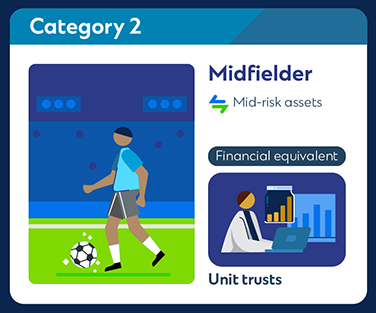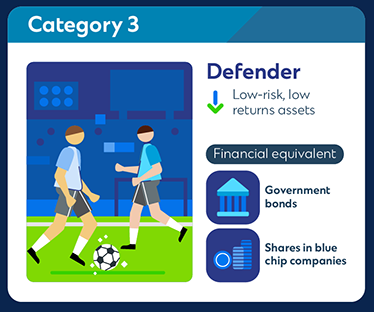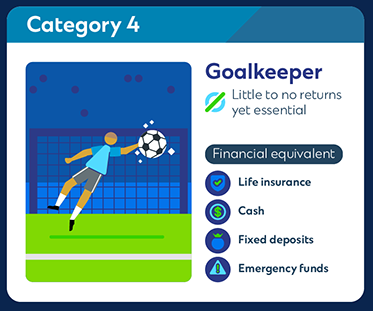Let’s take a leaf from the football management playbook to assemble a strong investment portfolio.
With football teams, players often get the limelight. However, a key person to the football team is the manager who oversees the players and crafts the winning strategies. As such, the success of football teams often lies on the shoulders of their managers – a good manager can make or break the team.
There is much to learn from football managers when it comes to building a successful investment portfolio.
Investments, much like football, has its own strategies and team setup. Employing the right tactics and investing in the right players can result in a Premier League-style portfolio.
Step 1. Build the Game Plan
There is no ‘one size fits all’ strategy for both football and investing. Every football manager has their own style. However, it is essential for every manager to have a game plan.
Before a match, a good football manager would set a specific goal. ‘Winning’ is of course the end game but being specific by pitting your strengths against the opponent’s weaknesses is better. For example, you would field more strikers or attacking wingers if you know there are gaps in your opponent’s defence. In investing, one could choose to increase your investment if you can afford it and market conditions are stable or keeping calm and staying invested even when markets are behaving erratically.
Additionally, they will evaluate their own team and their opponents’ players before crafting a strategy. In formulating the present strategy, football managers also make it a point to understand past performance, who plays well under which system, and who thrives under pressure.
Investors can similarly take reference from these strategies that football managers use to apply to their investment strategy: Set a specific goal, whether it’s capital preservation, income generation or capital growth along with a dollar amount to reach. You will also need to understand the risk and return of different types of investments (such as bonds, equities and unit trusts) along with your risk appetite (aggressive, moderate or conservative). This allows you to form the investment line up to achieve your financial goals.
Step 2. Assemble a Dream Team
A team that is comprised of all defenders or all strikers will be unbalanced. After studying the players, past performance, team dynamics and evaluating against competing teams, the football manager will then assemble the team setup.
This analogy applies to investments as well. Your investment portfolio should comprise of various asset classes with different risk characteristics. Investors should also consider market conditions because it could cause one asset class to do well but negatively impact another asset class.
There are four main ‘player’ categories to consider:
Category 1: Strikers – Flashy Match Winners
Characteristics: Strikers are known as the aces of a match. They help to amass impressive goal numbers. Strikers can sometimes bag a win, pulling up the poorly performing team, but they can also miss the mark and do not perform.
Investment Takeaway: Investors looking to go on the offense may take the same approach for more exciting investments. These include high-growth equities, smaller-capitalisation equities, and high-yield bonds. Such equities, much like strikers may provide good returns if they perform well. However, if there are no suitable investment vehicles to invest in, it is better to be a little conservative and hold off.
Category 2: Mid-fielders – Strong Core, Supports Striker & Defender
Characteristics: Midfielders are important, multi-talented players. They support strikers during attack strategies and help to defend the goal with the defenders when the opponent charges at them.
Investment Takeaway: Slightly more risk-averse or less risk seeking investors may consider unit trusts of where risks are connected to fluctuations in the market. Unit trusts have diverse holdings, sometimes across different geographic areas and asset classes (like bonds and equities), spreading out its risk. Investors can also choose unit trusts that suit their risk appetite as well as investment objective (for example, preserving capital, income generation or capital growth).
Category 3: Defenders – Not as Flashy but Dependable
Characteristics: The cornerstone of every football team, defenders are not as flashy as their striker
counterparts. While the attacking team members push through the opponents’ defense line, they usually stay close to the goal to prevent the opponent from scoring.
Investment Takeaway: Investment-wise, defenders hold similarities with bonds. Often called ‘boring’ investments, returns for these asset classes are more stable but understandably lower. Like the ‘Defenders’ in a football team, these asset classes tend to shine during the recession and market downturns.
Category 4: Goalkeeper – Every Team Needs One
Characteristics: In every football team, there are strikers, midfielders, and defenders but goalkeeper is one team member that a football team cannot do without.
Takeaway: Its financial equivalent would be cash, fixed deposits, and insurance. These aren’t investments but rather, financial must haves in any investment portfolio. These assets don’t guarantee any or very little returns especially cash and insurance. However, these provide you with a safety net in the event of retrenchment or personal accidents.
Meanwhile, health insurance helps to protect your savings and investments in the event of a medical emergency. There are also insurance plans which help you to save for the future with a lump sum payout after the plan reaches maturity.
Once you have assembled your team, next is training and preparing for different situations on the pitch.
Step 3. Make In-Game Decisions
Beyond having a thorough understanding of the players in your team and drafting sound strategies, a good football team manager adapts well to new challenges and circumstances. They will frequently review the team’s performance and will not hesitate to adjust strategies and bench players that are not performing as expected.
For example, if by half time, goals have not been scored, substitute a defender for a striker to push for a goal. Identify what’s not working and consider whether a change from the bench is warranted – either a tactical change or because a player is not performing.
Likewise, a successful investor should understand their risk appetite, investment goals and current financial situation before assembling their investment portfolio. It is also important to frequently review and rebalance your portfolios to optimise the performance of your investments. A smart investor would ideally rebalance their portfolio regularly to maintain his/her original allocation or desired level of risk over time.
Step 4. End of Season Review
Managing a football team and investing are long term commitments. Whether it is lifting the Premier League or saving for retirement, both require regular adjustments throughout the journey to ensure relevancy.
As a football team manager, it is important to conduct a review at the end of every season. You will be able to evaluate the performance of the team with all the highs and the lows. This allows you to gain new perspectives and formulate more winning tactics and strategies for the new season. This is also often when managers start to trade players for more appropriate ones.
Changes such as starting a family or getting old can be seen as a ‘new season’ as well. When you are younger, you may focus on building your wealth, taking one higher risk investments such as stocks.
As you age, the focus often shifts from wealth accumulation towards wealth protection. This is because your investment horizon naturally reduces over time. Hence, it is advised to increase the proportion of lower risk and stable asset classes with less but steady returns such as government bonds, as opposed to higher risk ones such as stocks.
View your investments through the lens of a football team
manager
Having a clear financial goal, understanding your ‘players’ and risk appetite, and conducting regular portfolio reviews will surely help you in your investment journey. Speak to our ‘coaches’ at Standard Chartered Bank on how best to invest and score your financial goals.
This article is for general information only and it does not constitute an offer, recommendation or solicitation of an offer to enter into any transaction or adopt any hedging, trading or investment strategy, in relation to any securities or other financial instruments. This article has not been prepared for any particular person or class of persons and does not constitute and should not be construed as investment advice or an investment recommendation. It has been prepared without regard to the specific investment objectives, financial situation or particular needs of any person or class of persons. You should seek advice from a licensed or an exempt financial adviser on the suitability of a product for you, taking into account these factors before making a commitment to purchase any product or invest in an investment. In the event that you choose not to seek advice from a licensed or an exempt financial adviser, you should carefully consider whether the product or service described herein is suitable for you.
You are fully responsible for your investment decision, including whether the investment is suitable for you. The products/services involved are not principal-protected and you may lose all or part of your original investment amount.
Standard Chartered Bank (Singapore) Limited will not accept any responsibility or liability of any kind, with respect to the accuracy or completeness of information in this article.
Singapore dollar deposits of non-bank depositors are insured by the Singapore Deposit Insurance Corporation, for up to S$100,000 in aggregate per depositor per Scheme member by law. For clarity, these investment products are not deposits and do not qualify as an insured deposit under the Singapore Deposit Insurance and Policy Owners’ Protection Schemes Act 2011. Foreign currency deposits, dual currency investments, structured deposits and other investment products are not insured.
The information stated in this article is accurate as at the date of publication.












